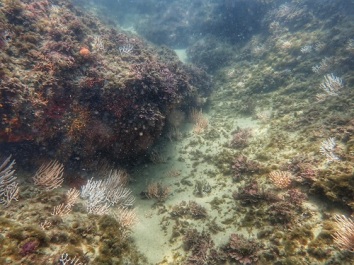
Research conducted by the Strandloper project is carried out by volunteers who assist on the transect dives.
Since January 2018 the Strandloper Project has been researching ghostfishing and the snag rate of recreation fishing tackle on the reef at Gericke’s Point and in Kingfisher Creek. The research has been able to distinguish fishing tackle snags by distinctly different means at the two sites.

In Kingfisher Creek the hooks snag on either Red bait or on the Mussel Beds on the rocks.
One method of snagging, in Kingfisher Creek, occurs when the hook becomes embedded in either the Red Bait or the beds of mussels that encrust the rocks in the estuary.
By contrast, at Gericke’s Point the fishing tackle is mainly snagged when the lead sinkers get caught on the reef and the attached baited hooks drift above the seabed or reef posing a distinct ghostfishing threat.
As our research has progressed we have also observed that sections of the reef in the high cast zone lack the rich biodiversity found on sections of reef that flank these zones. These recordings have led us to consider that the barren reefs are caused by a combination of both physical damage as fishing tackle is reeled in and a potential chemical contamination caused by lead poisoning.

Our fixed point photography surveys have show a distinct change in marine growth on the reefs at Gericke’s Point. Our research is to determine what factors are driving the transformation.
So, what you may ask, would cause lead poisoning in the estuary and ocean? Over the past two years on our 100m research transect at Gericke’s Point we have recovered 760 led sinkers, a staggering 7.6 lead sinkers per 1m. Of these, approximately 17% of the sinkers were recovered from a single outcrop of rock in the high cast zone. Not surprisingly, the zone around this out crop is all but devoid marine life, a probable consequence of lead poisoning.

Kingfisher Creek is a valuable fishing site for low income fishers working to secure a protein source to meet their dietary requirements.
Simultaneously, local Sedgefield resident Winston Barthus has pondered the consequence of lead poisoning in the estuary from the accumulation of lost lead sinkers over years. His solution? The production of a fishing sinker using natural material. A retired chemical engineer, he has worked out a means of attaching a swivel to a stone to produce a range of both a half and a one ounce sinker, that when lost, will have no detrimental impact on the estuarine or marine environment through lead contamination that lead sinkers can cause.
Extending our program for 2020, we would like to roll out an initiative to both encourage fishermen to convert to natural sinkers as well as crowdfund to supply subsistence fishermen using the estuary with a supply of natural sinkers to reduce the loss of lead into the system.
For more information on how to acquire a supply of stone sinkers contact Winston at sedge.ae@gmail.com.
